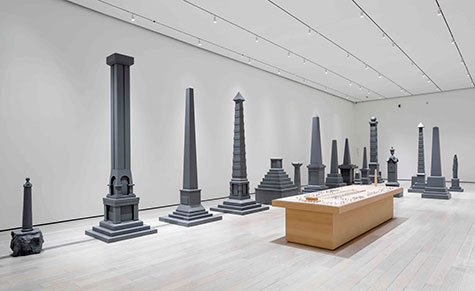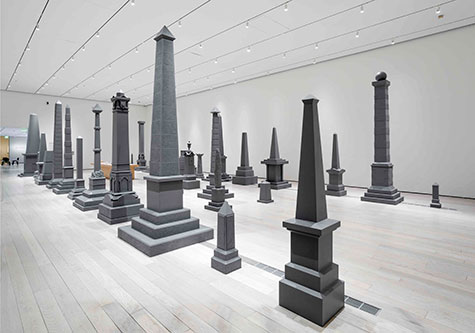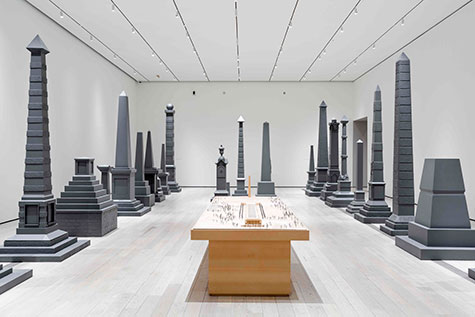
Monuments and memorials occupy complicated and often contested spaces of national identification. They commemorate tragic events. They honor the victims of wars, colonization and revolutions. But they also celebrate ideals of national power and unity in ways that shape our collective identity, sanitize violent — even genocidal — pasts and prioritize the viewpoints of the victors.

Over the last decade, artist Sam Durant has investigated these issues and crafted proposals that recast the monument as an artistic form of political critique, focusing on complex topics such as racism against black Americans and the exploitation and massacre of Native Americans.
This spring, the Mildred Lane Kemper Art Museum at Washington University in St. Louis will present “Sam Durant: Proposal for White and Indian Dead Monument Transpositions, Washington, D.C.” This large-scale installation, on loan from the Los Angeles County Museum of Art, consists of 30 minimalist sculptures, each appropriating the form of an existing monument to white and Indian victims killed between the 17th century and the end of the so-called Indian Wars in 1890.
The sources of Durant’s appropriations all share certain characteristics. All are permanent markers, all commemorate massacres involving groups of whites and Native Americans (as opposed to individuals) and all reference the traditional obelisk. Yet of the 30 he was able to identify, only five honor Native American victims. Tellingly, the majority of those — erected by whites in the 19th and early 20th century — memorialize “friendly Indians” who, to varying degrees, had been assimilated into white society.
“These monuments were erected by whites to serve their own interests and do not represent Indian perspectives, experiences or interests,” Durant writes in an artist statement. While violence is undoubtedly central to many war memorials, the task of memorials “is to justify and validate the loss of life as a necessary sacrifice …. The monuments do not raise questions about the conflicts or the use of violence, nor do they reveal the powerful interests that drove these conflicts.”
That disparity is evident not only in the sheer number of monuments, but also by the asymmetry of their contemporary contexts. For example, Durant points out that the Little Bighorn battlefield — where in 1876 Gen. George Custer led 260 men of the 7th Calvary to their deaths — is now a national park, complete with gift shop and visitor’s center. But the monument to Wounded Knee, where that same 7th Calvary massacred 200 virtually unarmed Lakota in 1890, languishes in a run-down graveyard on the Pine Ridge Reservation, one of the most impoverished places in the United States.

Though varying in size and detail, all of the monuments appropriated by Durant share a strong vertical thrust that pointedly resembles the massive stone structure of the world’s tallest obelisk: the Washington Monument on the National Mall in Washington, D.C. Indeed, the artist’s installation is a proposal to relocate the existing massacre memorials to the Mall. Monuments to white dead would be located on either side of the reflecting pool. Monuments to Indian dead would be installed on the lawn in front of the Washington Monument.
In addition to a scale model of the sculptures on the National Mall, Durant’s room-sized installation consists of the 30 large forms, all painted a homogenous gray, and constructed from MDF (medium-density fibreboard), fiberglass, foam, enamel, copper, basswood and birch veneer. These relatively impermanent — and sometimes incompatible — materials allude to the aesthetics of minimalism, appropriation art and the ready-made object while simultaneously criticizing the commanding authority of the obelisk, as evinced through its monumental presence and sense of permanence.
The result is a new artistic form, a hybrid of sorts, that Durant employs to interrogate America’s foundational narrative; to illuminate the significance of Native Americans to this narrative; and to demonstrate how it continues to advance unequal power relations today.
“Sam Durant: Proposal for White and Indian Dead Monument Transpositions, Washington, D.C.” is curated by Sabine Eckmann, PhD, the William T. Kemper Director and Chief Curator of the Kemper Art Museum.

Related events
An opening reception will take place from 7-9 p.m. Friday, Jan. 23. The exhibition will remain on view through April 13.
Eckmann will host a free gallery talk about the exhibition at 5 p.m. Monday, Feb. 9. Eckmann also will moderate a discussion with Durant and Candice Hopkins, the Elizabeth Simonfay Curatorial Resident in Indigenous Art at the National Gallery of Canada, at 6:30 p.m. Monday, March 16.
Other events will include a pair of talking circles, led by local artist and educator Tina Sparks, on Feb. 13 and March 13; and a gallery conversation, on March 30, between Eckmann and Angela Miller, PhD, professor of art history in Arts & Sciences at Washington University.
About the artist
Durant is a multimedia artist who frequently engages American history to create works that explore the relationships between culture and politics in topics ranging from the civil rights movement to southern rock music and modernism. The subject of seven monographic catalogs and books, his work has been displayed internationally and is included in many public collections, including the Tate Modern in London, Project Row Houses in Houston and the Museum of Modern Art in New York.
Durant’s curatorial credits include “Eat the Market” at the Los Angeles County Museum of Art and “Black Panther: the Revolutionary Art of Emory Douglas” — for which he also compiled and edited a comprehensive monograph — at The Museum of Contemporary Art in Los Angeles and the New Museum in New York. He has co-organized numerous group shows and artists benefits and is a co-founder of Transforma, a cultural rebuilding collective project that began in New Orleans.
Durant was a finalist for the 2008 Hugo Boss Prize and has received a United States Artists Broad Fellowship and a City of Los Angeles Individual Artist Grant. He teaches art at the California Institute of the Arts in Valencia, California.
Mildred Lane Kemper Art Museum
The Kemper Art Museum is located on Washington University’s Danforth Campus, near the intersection of Skinker and Forsyth boulevards. Regular hours are 11 a.m.-5 p.m. daily except Tuesdays and 11 a.m.-8 p.m. the first Friday of the month. The museum is closed Tuesdays.
For more information, call 314-935-4523; visit kemperartmuseum.wustl.edu; or follow the museum on Facebook and Twitter.
